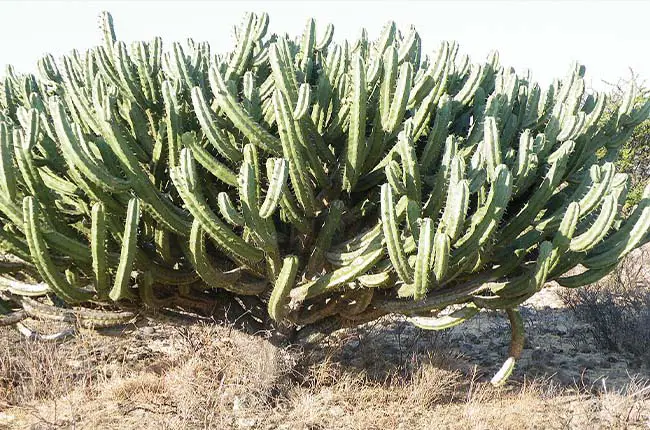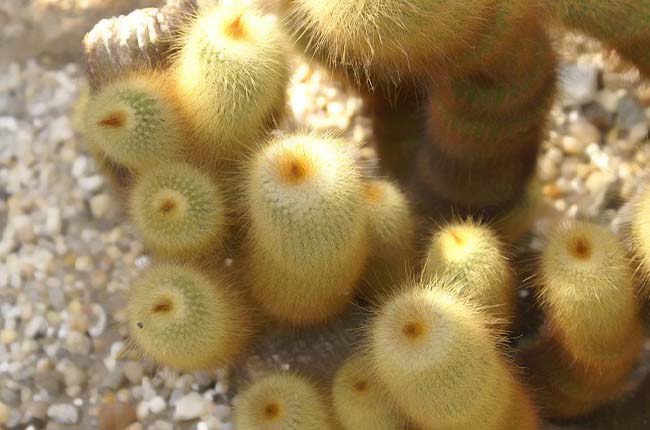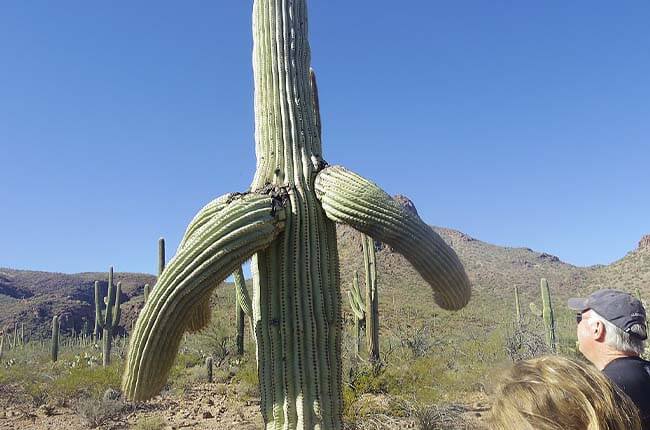Not all cacti grow arms.
Only arborescent and shrubby columnar types of cacti grow arms. Also, they must reach a mature age and height, and they must also be under healthy growing conditions.
In this article, we will explain the three factors that must be considered for a cactus to grow arms.
Factors for a cactus to grow arms
1. Columnar cactus vs. Globular cactus
Whether a cactus can grow arms depend first on the type of cactus.
There are nearly 2000 species of cacti and the majority of them do not grow arms. Only columnar type of cacti grows arms.
Columnar cacti are characterized by one single main cylindrical stem from which thick arms branch from the sides. Sometimes, new arms can also develop from older arms.
Columnar cacti can be the “arborescent” type. Such cacti are tall like a tree, with one main stem that can grow to great heights such as the Saguaro (Carnegiea gigantea) and San Pedro cactus (Echinopsis pachanoi), and Baseball bat cactus (Neoraimondia Herzogiana).

(Tyrv, CC BY-SA 4.0, via Wikimedia Commons)
Columnar cacti can also be the “shrubby” type which is shorter than the arborescent type. The arms of the shrubby columnar cactus develop close to the base of the plant with the main stem often buried in the ground covered by the soil. An example is the Totem Pole cactus (Pachycereus schotti).

(Amante Darmanin from Malta, CC BY 2.0, via Wikimedia Commons)
Here are some examples of columnar cacti:
- Saguaro (Carnegiea gigantea)
- Candelabra cactus (Myrtillocactus cochal)
- Baseball bat cactus (Neoraimondia Herzogiana)
- San Pedro cactus (Echinopsis pachanoi)
- Mexican giant cactus (Pachycerus pringlei)
- Blue-Myrtle cactus (Myrtillocactus geometrizans)
- Totem pole cactus (Pachycereus schottii)
Cacti that do not grow arms are short and round in shape, thus known as “globular cacti”. The Opuntia genus also does not grow arms although they grow flattened pads that look like thickened leaves but are actually modified stems.

(Karelj, Public domain, via Wikimedia Commons)
Here are some examples of globular cactus and Opuntia species that do not grow arms:
- Organ Pipe Cactus (Lemaireocereus thurberi)
- Mexican fence post cactus (Stenocereus marginatus)
- Golden Ball Cactus (Parodia leninghausii)
- Prickly pear cactus (Opuntia ficus indica)
- Claret Cup Cactus (Echinocereus triglochidiatus)
- Beavertail Cactus (Optunia basilaris)
- Turk’s Cap Cactus (Melocactus matanzanus)

(Photo by David J. Stang, CC BY-SA 4.0, via Wikimedia Commons)
However, not all columnar cacti have arms. Two other factors must be considered.
2. Age of cactus
Only mature columnar cacti start growing arms after reaching a certain age and height, which can take between 5 years up to even 100 years, depending on the species.
Cacti species that can grow arms have to reach a certain age and height before the arms appear. The required age and height depend on the species.
The Saguaro cactus, which is slow-growing species, only grows arms when the plant is around 16 feet (4.8 meters) tall and between 75 to 100 years old, depending on the amount of precipitation and nutrients it gets.
The Mexican giant cactus, a close relative of the Saguaro cactus, has similar age and height requirements to start growing arms. Studies show that the average height before branching starts is 5 meters (16.4 ft).
On the other hand, fast-growing cacti like the San Pedro cactus can start growing arms as quickly as 5 or 6 years, at which point the plant is over 6 ft (1.83 m) tall.
So, if you have a columnar cactus, you need to first determine the age of the cactus to know when it can start to grow arms.
3. Growing conditions
Columnar cacti grow arms when they are healthy and have adequate water, nutrients, and light.
Cacti generally grow limbs when there’s sufficient water and light. This is because growing arms is an intense process that requires energy and resources.
This is confirmed by a study by the U.S. National Park Service which observes that cacti in areas of low precipitation take longer to grow arms.
Also, cacti grow arms as a way to reproduce. More arms will produce more flowers which will attract pollinators like bats, birds, and insects. The pollinated flowers will in turn become fruits and produce seeds for dispersal.
However, reproduction is secondary to survival. A cactus that’s constantly experiencing drought conditions, poor lighting, and malnutrition may never grow arms. Such cacti are more concerned with using the limited water and light to continue growing, rather than sending out arms for flower production.
Can I make my cactus grow arms?
Providing adequate water, light, and nutrients steadily over a long period can encourage a mature columnar cactus to grow arms.
First determine if your cactus is a type that can grow arms, which must be a columnar type rather than a globular type. If your cactus is not a columnar type, nothing you do will ever make it grow arms.
To help columnar cacti grow arms, the trick is to keep them healthy, well-watered, well-fed, and with adequate light. Cacti that aren’t stressed, affected by disease or pests, and have adequate water and nutrients grow better and produce arms faster compared to cacti with less-than-optimal growing conditions.
This is because growing arms is an energy-consuming process and the cacti will only grow arms if it has enough resources to do so. If there’s not enough water, light, and nutrients, the plant will instead focus on growing tall than producing branches.
But simply watering more often will not make your cactus grow arms immediately. It will take a period of steady and continued supply of adequate watering and fertilizing before arms will appear. This is because the cactus first needs to become healthy enough and also amass the resources needed to grow arms.
Which cactus has the most and biggest arms?
The Saguaro cactus probably has the biggest arms, due to its impressive size, shape, and lifespan.
Native to the Sonoran Desert in northern Mexico, southern Arizona, and California, Saguaros are a tree-like columnar cactus that can reach up to 50 feet (15 meters).
A mature Saguaro has the biggest arms which can hold as much as 30 to 40 gallons (110-150 liters) of water, and weigh up to 250 pounds (113 kilos).
How many arms can a cactus develop?
In the case of Saguaro cacti, they do not develop more than 10 to 20 arms.
The number of arms a cactus can grow depends on the climate and how fast the plant grows.
Wetter climates promote faster growth, thus producing more branches. For example, in the driest locations of a desert, even the oldest cactus may never grow arms.
Saguaros can have as many as 25 or more arms, while some can have just a couple and others none at all. The tallest cactus on record was an armless saguaro, measuring 78 feet (23.7 meters). Like other columnar cacti, the development of arms depends on the water conditions.
Do San Pedro cacti grow arms?
San Pedro cactus is a columnar cactus and will grow arms when it matures and if the conditions are right.
The San Pedro cactus is a fast-growing columnar cactus. As an arborescent columnar cactus, the San Pedro can and frequently grows arms.
Arms typically develop when the plant is 6 to 7 ft (1.83 to 2.13 m) tall, which under proper conditions of adequate watering, light, and nutrition takes about 5 to 6 years.
The arms grow upward from the sides of the main/central stem of the plant, and new arms can grow from the older arms.
Why do cactus arms grow pointing down?
Trauma from hard frost can weaken fibers within the branch and cause the arm to droop, and point down.
Healthy cactus arms naturally grow upright and parallel to the main stem. It is not a unique growing habit for cactus arms to grow downwards.
When saguaro tissues are damaged by accident or by freezing temperatures, the cells are damaged and can no longer hold water. The joints then lose their normal turgidity and become mushy, allowing the branch to droop.
Usually, there are visible signs of trauma and weakness on the down-pointing arm, especially at the joint with the main stem, which usually appears twisted or creased.
The joint between the arms and the main stem (or older arms) usually isn’t very strong. Arms that are pointing down are more vulnerable and may break after a strong wind. If the arm lands on the soil it can root into a new cactus.
As long as they are on the plant, down-pointing arms remain functional and will produce flowers during inflorescence. They also give the cactus a unique appearance.

(WClarke, CC BY-SA 3.0, via Wikimedia Commons)
Related:
4 Ways To Determine The Age Of Cactus
Top 18 Columnar Cacti (with Pictures)
Top 14 Variegated Cacti (with Pictures)
14 Fragrant Succulents & Cacti (You Will Love)
Saguaro Cactus: 28 Little-Known Fun Facts
(Photo credits: Frank Vincentz, CC BY-SA 3.0, via Wikimedia Commons)
References
Delgado-Fernández, M., Garcillán, P. P., & Ezcurra, E. (2017). The giant columnar cactus Pachycereus pringlei adaptively modifies its stem shape from the dry tropics into the arid mid-latitude deserts. Journal of Arid Environments, 146, 10–17.
Gilman, E. (n.d.). Opuntia spp. Prickly Pear Cactus.
U.S. National Park Service. Saguaro Cactus Growth.
- Keiki Paste vs Rooting Hormone:What’s the difference? - February 4, 2024
- Top 10 Orchid Fertilizers: A Comprehensive Review (2024) - February 2, 2024
- Top 8 Soil Inoculants For Stronger Plants (2024) - February 1, 2024


